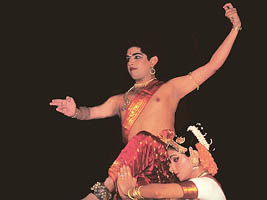Indian Classical Dance
Today there are a great number of various dancing traditions in India among
which the following are marked out: are marked out:
1. Classical dances
2. Semi-classical dances
3. Folk dances
4. Pop dances
The classical dance forms which trace back their roots deep into the Past, into
the times of ritual temple divine services undoubtedly arouse the greatest
interest.
Altogether 7 of such forms are marked out:
1. Kuchipudi
2. Bharatanatyam
3. Kathak
4. Odissi
5. Kathakali
6. Manipuri
7. Mohiniattam
The three aspects - the Nritta, the Nritya and the Natya lay at the heart of
each of these forms.
The Nritta is a rhythmic sequence that ends in either singing or in lyrics
reciting.
The Nritya is a sum of rhythmic patterns each following a certain pantomimic
interpretation (or abhinaya)
The Natya is a complete dance drama with a story-line and various characters.
Each dance form is a unique combination of these three aspects, each one
possesses its own peculiarity, but Kuchipudi fully deserves its reputation of
being the most beautiful and the most complex one among the above mentioned
dance forms.
What is Kuchipudi? This is a unique charm that you get from subtle blending of
unsurpassed technique with The Art of Drama that gets its inspiration in
scriptures and mythology. Energetic jumps and turns, brave and sense full play
of eyes, the vortex of uncommonly quick and skilled motions followed by a
cascade of statuesque poses, that what Kuchipudi is!
A Kuchipudi dancer is required to possess not only perfect calisthenics but also
perfect plasticity and developed sense of rhythm, be competent in mudras (hand-gestures
with sacral meaning) and possess a thorough mastery of abhinaya (the art of
pantomime). A combination of all these qualities in the presence of enormous
inner energy and ability to instantly transform oneself into different
characters allows the audience to perceive the dance art of Kuchipudi as light,
igniting and bewitching act. Performing dances on the edges of a brass plate,
executing complicated rhythmic patterns with dexterity, while sometimes also
balancing a pot of water on the head is considered to be the highest level of
mastery.
The Kuchipudi dance form developed in what is now known as the state of Andhra
Pradesh in southern India. Kuchipudi derives its name from the village
Kuchelapuram on the bank of the river Krishna. According to a legend, sultan
Mohamed Kuli Kutab-Shahs' elder nephew Abdul Tana-Shah was sent to the village
Kuchipudi to supply it with water. A well was dug out by the order of Tana-Shah.
The joy of the village dwellers knew no limits and in order to express their
gratitude they organized a grand performance where they demonstrated their art
of dancing. Being a great connoisseur of art, Abdul Tana-Shah was so impressed
by the dance drama that he granted the village of Kuchipudi to the artists with
the promise that they would continue the tradition of performing. From that day
onwards this dance form became known as Kuchipudi.
But Kuchipudi provides to have been popular long before Tana-Shah.
Over 3000 years ago Bharata Muni the author of Natyashastra (a holy writ
dedicated to the Art of
 Drama) explained some aspects of dance referring to this
particular dance form. Sculptural compositions undoubtedly belonging to the same
tradition were found in ancient temples and Buddhist monasteries such as
Nagarjunakonda, Amaravathi and Ghantsala. Drama) explained some aspects of dance referring to this
particular dance form. Sculptural compositions undoubtedly belonging to the same
tradition were found in ancient temples and Buddhist monasteries such as
Nagarjunakonda, Amaravathi and Ghantsala.
Since the moment of its origin and up to the present day Kuchipudi has undergone
multiple changes.
By its origin Kuchipudi was a dance drama where each character was given one and
strictly assigned part, but now Kuchipudi is basically a solo dance form. Within
one performance and often within one item on the programme a dancer transforms
into several absolutely different characters.
In ancient times Kuchipudi could be performed only in temples, but nowadays
performances can be set on stage as well as in the open air.
And, finally, the most important thing. Earlier Kuchipudi could be performed
exclusively by men and women were not permitted to perform this dance form
because their beauty was believed to draw attention of spectators from the
divine meaning of the drama. Moreover, men used to play all female parts and not
only put on women's dress but also had to make themselves up as women. Changes
touched Kuchipudi in 1950s when indeed a revolutionary event took place: women
were at last permitted to dance! and women were not permitted to perform this dance form
because their beauty was believed to draw attention of spectators from the
divine meaning of the drama. Moreover, men used to play all female parts and not
only put on women's dress but also had to make themselves up as women. Changes
touched Kuchipudi in 1950s when indeed a revolutionary event took place: women
were at last permitted to dance!
In this Kuchipudi owes a debt to the Great Guru Vempati Chinna Satyama who
besides all other things holds the merit in spreading this style beyond India
frontiers.
And we, a studio of classical Indian dance "Ananda Tandava" being followers of
the Great Master Vempati Chinna Satyama, are happy to continue the glorious
Kuchipudi tradition in Russia.
| 